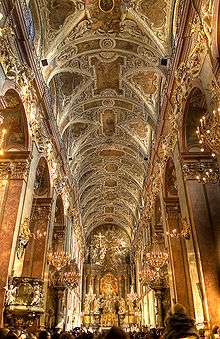Jasna Góra Monastery
 | |
 Location within Poland | |
| Monastery information | |
|---|---|
| Established | 1382 |
| Site | |
| Location | Częstochowa, Poland |
| Coordinates | 50°48′45″N 19°05′50″E / 50.81250°N 19.09722°ECoordinates: 50°48′45″N 19°05′50″E / 50.81250°N 19.09722°E |
| Public access | yes |
The Jasna Góra Monastery (Polish: Jasna Góra, Luminous Mount, Hungarian: Fényes Hegy, Latin: Clarus Mons) in Częstochowa, Poland, is a famous Polish shrine to the Virgin Mary and one of the country's places of pilgrimage – for many the monastery is a spiritual capital. The image of the Black Madonna of Częstochowa, also known as Our Lady of Częstochowa, to which miraculous powers are attributed, is one of Jasna Góra's most precious treasures.[1]
The site is one of Poland's official national Historic Monuments (Pomnik historii), as of 16 October 1994[2] and is tracked by the National Heritage Board of Poland.
Among the monastery's many treasures and artifacts of interest is the medal from the 1983 Nobel Peace Prize received by Lech Wałęsa, the former Polish president and trade-union organizer.[3]
History

by January Suchodolski

Jasna Góra Monastery was founded in 1382 by Pauline monks who came from Hungary at the invitation of Władysław, Duke of Opole. The monastery has been a pilgrimage destination for hundreds of years, and it contains an important icon of the Virgin Mary. The icon, depicting the Mother of God with the Christ Child, is known as the Black Madonna of Częstochowa or Our Lady of Częstochowa, which is widely venerated and credited with many miracles.[4] Among these, it is credited with miraculously saving the Jasna Góra monastery during the Siege of Jasna Góra that took place at the time of The Deluge, a 17th-century Swedish invasion. The event stimulated the Polish resistance. The Poles could not immediately change the course of the war, but, after an alliance with the Crimean Khanate, they repulsed the Swedes. Shortly thereafter, in the cathedral of Lviv, on April 1, 1656, Jan Kazimierz, the King of Poland, solemnly pronounced his vow to consecrate the country to the protection of the Mother of God and proclaimed Her the Patron and Queen of the lands in his kingdom.
Walking pilgrimages

by Adrian Głębocki
Every year since the Middle Ages, thousands of Poles go in pilgrim groups to visit Jasna Góra. In 2011, it was estimated that 3.2 million pilgrims from 80 countries went to the shrine. Around 830,000 pilgrims took part in 228 pilgrimages organized in different places across Poland, 143, 983 of which reached the monastery on foot.[5] The average distance for a pilgrim group to travel is about 350 kilometres (217 miles), made in 11 days.[6]
Monastic etiquette
There are typically numerous pilgrims and tourists at Jasna Góra Monastery, and the volume of excited voices can be high. However, upon entering the Monastery, it is expected etiquette for visitors to be silent or as quiet as possible out of respect. Often, there is a long line of people who wait to approach the shrine of the Black Madonna of Częstochowa. Upon arriving at the location of the shrine where one would pass in front of the icon of Our Lady, it is expected and a sign of respect for pilgrims to drop to their knees, and traverse the anterior of the shrine on their knees.
Gallery
- Jasna Góra Monastery
 The main nave of the basilica
The main nave of the basilica- Pilgrims arriving for the Feast of the Assumption
- Benedict XVI on Jasna Góra in 2006
 Pilgrims reach Jasna Góra, 1993
Pilgrims reach Jasna Góra, 1993 View of the tower
View of the tower- Interior of the monastery
- Knights' Chamber
 Main Altar
Main Altar Organs inside the main building
Organs inside the main building.jpg) Lubomirski Gate
Lubomirski Gate- Statues in the monastery
- Pilgrims visiting the monastery in 2012
- Monastery building
- View of the park
- One of the Stations of the Cross
See also
References
Bibliography
- Czesław Ryszka. W Maryjnej Twierdzy. Jubileusz zwycięskiej Obrony Jasnej Góry (in Polish). Urząd Miasta Częstochowy. Archived from the original on January 4, 2014. Retrieved 2013-07-24.
- Aleksander Radecki (1990). Piesza Pielgrzymka Wrocławska 1981–1989. Mokrzeszyn.
- Jan Pach; Włodzimierz Robak; Jerzy Tomziński (2001). Jasna Góra. Sanktuarium Matki Bożej. Przewodnik (in Polish). Częstochowa: Wydawnictwo Zakonu Paulinów.
- Mirosław Zwoliński (1997). Przewodnik po Częstochowie (in Polish). Częstochowa. pp. 87–112.
Notes
- ↑ "Częstochowa official website". Urząd Miasta Częstochowy, Śląska 11/13, 42–217 Częstochowa. Archived from the original on 2009-02-08. Retrieved 2008-10-22.
- ↑ "Zarządzenie Prezydenta Rzeczypospolitej Polskiej z dnia 8 września 1994 r. w sprawie uznania za pomnik historii". SEJM.gov.pl. Retrieved 2016-03-17.
- ↑ Kifner, John (13 December 1983). "Walesa Takes Nobel Medal To Polish Shrine". Retrieved 30 January 2017.
- ↑ "Jasna Góra". 1998–2008 Copyright by Klasztor OO. Paulinów Jasna Góra – Częstochowa. Retrieved 2008-10-22.
- ↑ "Jasna Góra 2011 Statistics". Retrieved 2017-06-17.
- ↑ "Telewizja Dami – Grupa Medialna". Telewizja.radom.pl. 2012-08-15. Archived from the original on 2014-01-04. Retrieved 2013-03-12.
External links
| Wikimedia Commons has media related to Jasna Góra Monastery. |
- Jasna Góra website(in English) (in Polish) (in Spanish) (in German) (in Italian)
- Jasna Góra and the Shrine of Our Lady of Częstochowa